Vanilla takes the crown as the second most valuable spice (after saffron) and the world’s most popular flavor among consumers.

University of Florida researchers in Homestead are on the verge of developing a domestic vanilla industry, poised to transform agriculture in Florida, Puerto Rico and the U.S. Virgin Islands for interested small growers and investors.
Thanks to nearly $400,000 in grants from the U.S. Department of Agriculture Southern Sustainable Agriculture Research and Education (USDA-SSARE) program, scientists at the University of Florida Institute of Food and Agricultural Sciences (UF/IFAS) can now pick up the pace on the most critical phase of an ongoing vanilla-breeding program, blooming since 2017.
This research stage is key because it will identify varieties with high yields, disease resistance, high vanilla content and nutrients in plants to develop the best fertilizer recommendations. Scientists will also identify potential plant pollinators, while working with growers.
“Vanilla is a highly profitable crop with cured beans, worth $250 to $600 a kilogram,” said Xingbo Wu, a plant breeder and geneticist at the UF/IFAS Tropical Research and Education Center. “With appropriate plant material and production guidance, we can maximize the return on investment in domesticated vanilla production.”
Madagascar leads the world in vanilla production, supplying more than 80% of the world’s vanilla, while Indonesia, Uganda, India, Comoros, Mexico and other countries significantly contribute to global production. The United States is the biggest importer of vanilla beans from Madagascar, and once in America, those beans are processed into vanilla extract.
“We calculate the United States could be the fifth largest vanilla producer globally with 140 to 670 acres devoted to this specialty crop,” said Wu. “Our goal is to determine the best vanilla material and efficient production management of growing vanilla in southern Florida, Puerto Rico and the Virgin Islands, disseminate this information to all potential growers and guide the vanilla breeding projects.”
Wu and his team will analyze light and nutrient requirements for maximum vanilla production and determine the appropriate environment settings for vanilla cultivation with collaborative growers from different geographic regions. They are also exploring ways to pollinate vanilla plants, which are traditionally labor-intensive. Due to the unique reproductive structure of the flower, vanilla plants are pollinated by hand.
“The emerging domestic vanilla market requires a supply chain to move the product efficiently from farm to end users,” said Wu. “This project was designed to overcome these challenges and could have major impacts on productivity, profitability and rural communities.”










